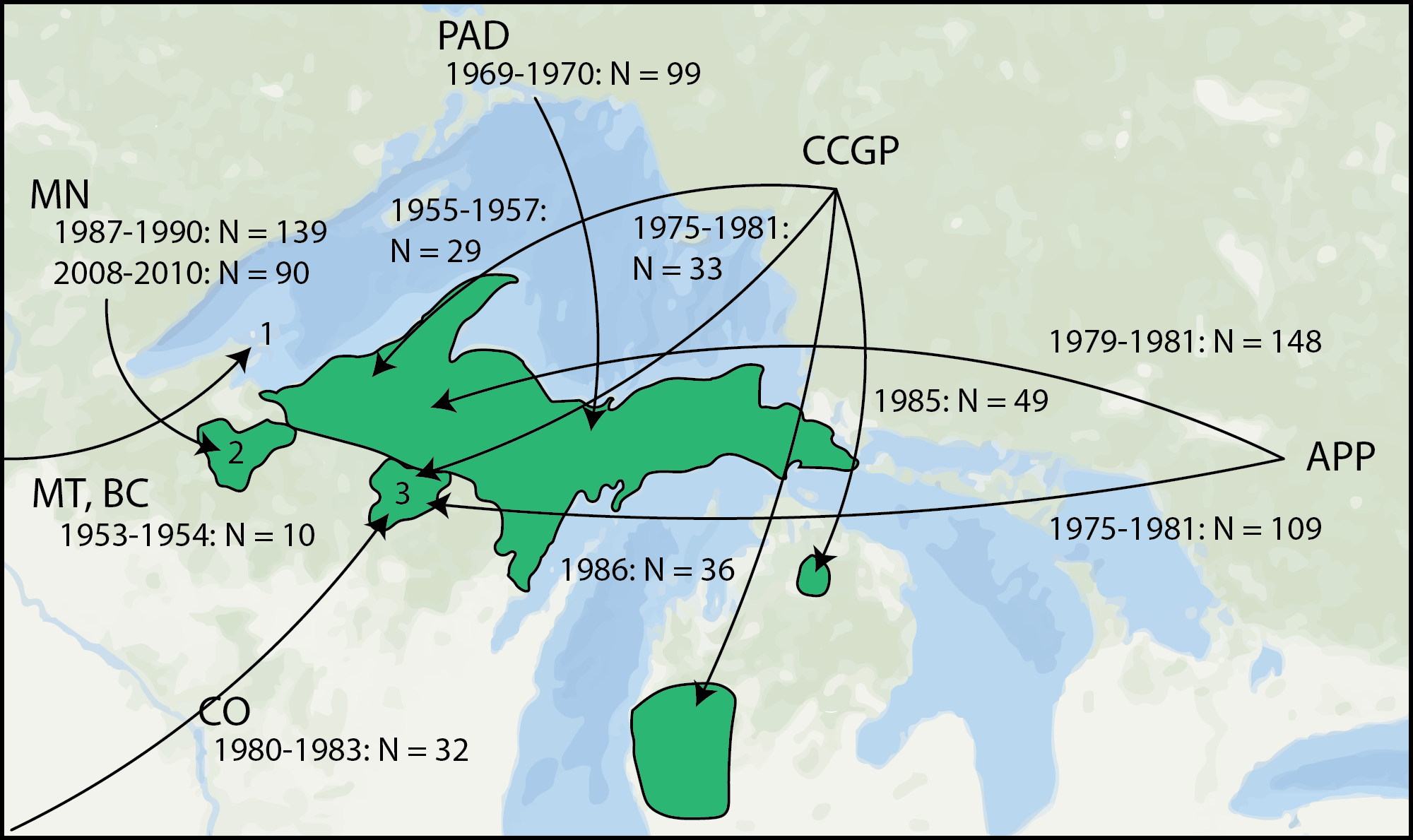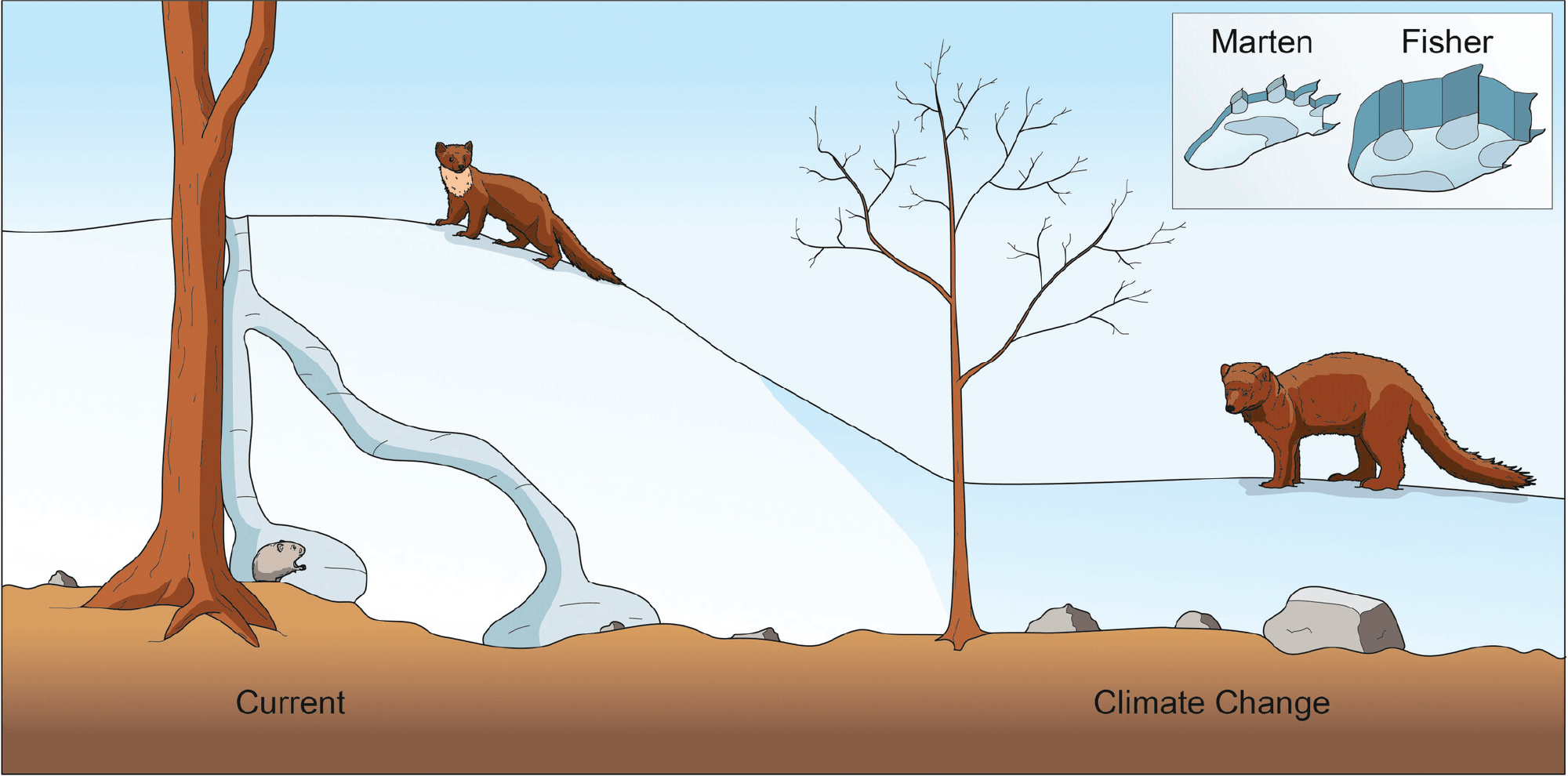The Pauli lab has been researching marten (Martes spp.) and fisher (Pekania pennanti) across the United States for over a decade. Much of this research has focused on martens and fishers in the Great Lakes Region and Alaska, and fishers in the Sierra Nevada. This work includes investigating fundamental questions in ecology regarding competitive interactions and applied questions in species recovery.
Assessing Multiple Dimensions of Marten Recovery in the Great Lakes Region
American martens (Martes americana) are one of the most frequently translocated (>50 times) carnivores in North America, yet the translocation success rate is low. Along their southern range boundary in the Great Lakes Region, martens were extirpated by the 1930s across much of the region. In the 1950s, the first translocations occurred with the release of 10 adult martens to the Apostle Islands, Wisconsin. The last reported observation on the Apostle Islands occurred in 1969 and the translocation was considered a failure. Additional regional translocations began and continued until 2010 that established sub-populations across upper Michigan and two disjunct populations in northern Wisconsin. Despite these efforts, martens still remain the only state-endangered mammal in Wisconsin and regionally the long-term viability of this species is uncertain. Previous research in the Pauli lab confirmed this uncertainty due to small population sizes, a lack of connectivity, low juvenile recruitment, and dietary constraints.

Reintroduction history for American martens in the Great Lakes region, with arrows showing the years, numbers of individuals, and source locations for each reintroduction event. The first reintroductions to the Apostle Islands National Lakeshore (1) consisted of 10 martens from Montana (MT) and captive-reared stock from Canada (BC). The Chequamegon National Forest (2) martens came from a source in northeastern Minnesota (MN), USA. Sources for the Nicolet National Forest (3) include Colorado (CO), USA, and the Crown Chapleau Game Preserve (CCGP) and Algonquin Provincial Park (APP) in Ontario, Canada. Reintroductions in the Upper Peninsula of Michigan were sourced from CCGP, APP, and also the former Port Arthur Ontario Ministry of Natural Resources District (PAD), Ontario. All martens reintroduced in Michigan’s Lower Peninsula were sourced from CCGP. Adapted from Grauer et al. 2017 Cons. Bio.
Since 2004, martens have been non-invasively genotyped across the Great Lakes Region, resulting in the genetic tagging of >1,000 georeferenced genetic samples. Through the genetic tagging of martens in the lab, we have quantified the demographic attributes and processes of subpopulations, the impact of augmentation on a reintroduced population, the influence of immigration on recovering populations, and the effect of founding populations. Despite extensive research on individual translocations, it is unclear how well these subpopulations are connected and how the relationships of these subpopulations could create a recovery network and aid in species recovery along this trailing range boundary. While past research has suggested low levels of connectivity throughout the region, more recent work has revealed populations are more connected than previously believed. Indeed, research in the lab using genetic data and simulations has documented the contemporary recolonization of two regional archipelagos: the Apostle Islands and Isle Royale. This, coupled with recent calls for more thorough investigations into the current state of marten connectivity in the Great Lakes recovery network, has prompted efforts in the Pauli lab to measure the functional connectivity of martens.
To generate estimates of functional connectivity across the Great Lakes recovery network, we are generating a resistance landscape of marten connectivity across the Great Lakes states of Minnesota, Wisconsin, and Michigan. By incorporating circuit theory, the Pauli lab hopes to map connectivity corridors throughout the region and understand movement pathways across landscapes of various costs to marten dispersal. Concurrently, we are w quantifying the influence of landscape characteristics on survival and estimating recruitment through parentage analysis and litter counts. Through this work, the Pauli lab hopes to pinpoint limiting factors to marten recovery in Wisconsin and the Great Lakes Region as a whole by generating an understanding of recovery network connectivity and estimating recruitment in one of its most troubled recovery areas of the Chequamegon National Forest.
Interspecific Competition Between Martens and Fishers
Competition plays a major role in where species occur and how they interact with their environment. Carnivores in particular experience strong interspecific competition due to similar morphological and behavioral characteristics and dietary overlap. Among carnivorans, martens and fishers exhibit strong interspecific interactions due to similar body sizes, inhabiting similar landscapes and primarily consuming small mammalian prey. Since martens and fishers exhibit high degrees of diet and habitat overlap across their ranges, this overlap is likely to have the greatest fitness consequences for the smaller and subordinate martens. From past research in the lab, we have quantified significant spatial and dietary overlap between martens and fishers that may be contributing to the delayed recovery of martens in Chequamegon National Forest.

Martens Martes spp. and fishers Pekania pennanti co-occur broadly in their geographical ranges. In areas of sympatry, however, deep powdery snow can create snow refugia for martens, for two reasons. First, martens are much lighter, possess lighter foot loads and therefore can traverse across the top of the snow rather than sinking in; fishers, on the contrary, are sufficiently heavy to sink into the snowpack due to their heavier foot loads and incur energetic costs in deep snow. Second, deep snow creates a subnivium, where martens can forage efficiently on important prey species (e.g. arvicolid rodents), whereas larger fishers are unable to exploit these prey. With warming climate generally creating shallower and denser snowpack for shorter durations, snow refugia are likely to become increasingly rare in many areas of marten and fisher sympatry. See Pauli et al. 2022 Mamm. Rev.
We are continuing research into the mechanisms that shape and mediate dietary niche overlap and ultimately competitive interactions between martens and fishers. At the population and individual level, we are quantifying the isotopic niche, proportional diets, and individual specialization across a gradient of competitive influence. In addition, we are interested in testing the mechanisms that may influence the population niche and individual specialization including interspecific competition, intraspecific competition, resource availability, and habitat heterogeneity.
Notably, while members of Guloninae are typically described as generalist carnivores, consuming fungi, plants, or insects in times of need, recent literature has suggested that these species may have the physiological capability to digest other dietary items, such as fungi or insects. Previous work in the Pauli Lab has discovered that fishers along the Western slope of the Sierra Nevada Mountains primarily consume fungi (47%) and little vertebrate mass (14%), while consuming a greater percentage of insects during drought conditions. This is in stark contrast to diets that are predominantly vertebrate prey across much of their range. While fishers have shown great plasticity in their foraging and diet, the means and capacity for this flexibility are poorly understood.
There is little known about how members of Guloninae are able to digest a primarily non-carnivorous diet such as fungi or insects given their carnivorous adaptations: simple gastro-intestinal tracts, digestive enzymes for high concentrations of uric acid in meat, and carnassial teeth to sheer flesh. Therefore, the Pauli lab hopes to characterize the capacity of members of Guloninae to digest different diets and identify the physiological mechanisms behind their divergent foraging strategies. We hypothesize that these species will differ in digestive enzymes and gut microbiome, and these differences are the mechanism by which these species have segregated their niches. This work will reveal the evolutionary basis behind niche differentiation and coexistence of this phylogenetically related and competitive group of carnivores and will provide critical data on the foraging ecology of these species.
Project Members: Emma Blackdeer, Lydia Druin
This work is funded by the US Forest Service Sierra Nevada Carnivore Monitoring Program, US Forest Service, and Pacific Northwest Research Station.
